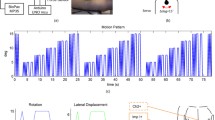Abstract
Movement-induced potentials of streaming potential type were studied in various electrode configurations. The geometric design of the electrode was important for the reduction of noise generated by the movements of gel. Potential and impedance variations were measured for electrode movements in electrolytes. The impedance variations were small and the streaming potentials were electrolyte-concentration dependent and in the order of 10μV. The same type of study was carried out for electrodes applied to the skin. The conclusion from this experiment is that skin deformation potentials dominate the disturbance pattern in this type of recordings.
Similar content being viewed by others
References
Almasi, J. J. andSchmitt, O. H. (1974) Automated measurement of bioelectric impedance at very low frequencies.Comput. & Biomed. Res.,7, 449–456.
Ask, P., Öberg, P. Å., Ödman, S., Tenland, T. andSkogh, M. (1979) ECG Electrodes: A study of electrical long-term properties.Acta Anaesth. Scand.,23, 189–206.
Bickford, R. G. (1974) Quantitative techniques in EEG. InMedical Engineering,Ray,C. D. (Ed.) Year Book Medical Publishers, Chicago, 385–404.
Bockris, J. O'.. andReddy, A. K. N. (1974)Modern electrochemistry, Plenum, New York, 826–835.
Boter, J., den Hertog, A. andKuiper, J. (1966) Disturbance free skin electrodes for person during exercise.Med. & Bio. Eng.,4, 91–95.
Burbank, D. P. andWebster, J. G. (1978) Reducing skin potential motion artefact by skin abrasion.Med. & Bio. Eng. & Comput.,16, 31–38.
Chapman, D. L. (1913) A contribution of the theory of electrocapillarity.The London, Edinburgh and Dublin Philosophical Mag. and J. Sci.,25, 475–481.
Edelberg, R. (1973) Local electrical response of the skin to deformation.J. Appl. Physiol.,34, 334–340.
Edelberg, R. (1968) Biopotentials from the skin surface: The hydration effect.Ann. N.Y. Acad. Sci.,148, 252–262.
Edelberg, R. (1967) Electrical properties of the skin. InMethods in psychophysiology,Brown,C. C. (Ed.), Williams & Wilkins, Baltimore.
Fowels, D. (1974) Mechanism of electrodermal activity. InBioelectric recording techniques.Thompson, R. F. andPattersson, M. M. (Eds.), Part C, Academic Press, New York.
Geddes, L. A. (1972)Electrodes and the measurement of Bioelectric events, Wiley Interscience, New York, 3–106.
Gouy, A. (1910) Sur la constitution de la charge électrique à la surface d'un électrolyte.J. de Physique,9, 457–468.
Helmholtz, H. (1879) Studien über elektrische Grenzschichten.Ann. Phys. Chem.,7, 337–382.
Kahn, A. (1965) Motion artifacts and streaming potentials in relation to biological electrodes.Digest of the 6th Int. Conf. Med. Electr. and Biol. Eng., Tokyo, 562–563.
Kahn, A. andGreatbach, W. (1974) Physiological electrodes: Electrodes for physiological measurement. Electrode artefacts. InMedical engineering,Ray,C. D. (Ed.), Year Book Medical Publishers, Chicago, 1078.
Kossman, C. E., Brody, D. A., Bruch, G. E., Hecht, H. H., Johnston, F. D., Kay, C., Lepeschkin, E., Pipberger, H. V., Baule, G., Berson, A. S., Briller, S. A., Geselowitz, D. B., Horon, L. G. andSchmitt, O. H. (1967) Report of Committee on Electrocardiography, American Heart Association. Recommendations for standardization of lead and specifications for instrumentations in electrocardiography and vectorcardiography.Circulation,35, 583–602.
Lijklema, J. (1964) The measurement and interpretation of electric potentials from a physicochemical point of view.In Med. Electron. Proc. 5th Int. Conf.,Bostem, F. H. (Ed.).Med. electron. Liege,2, 458–479.
Maroudas, A. (1968) Physicochemical properties of cartilage in the light of ion exchange theory.Biophysical J.,8, 575–595.
Ödman, S. (1980) Method for measurement of potentials and impedance variations synchronous with electrode movements. Linköping University, Linköping, Sweden (in Swedish).
Prokasy, W. F. andRaskin, D. C. (1973)Electrodermal activity in psychological research. Academic Press, New York and London, 2–109.
Spiegler, K. S. (1974) On the measurement of streaming potentials with silver-silver chloride electrodes.Desalination,15, 135–140.
Tam, H. W. andWebster, J. G. (1977) Minimizing electrode motion artifact by skin abrasion.IEEE Trans. BME-24, 134–139.
Watanabe, A. (1963) AC Methods in interfacial electrical phenomena.J. Electroch. Soc., 72–79.
Wolf, H. K., Mac Innis, P. J., Fack, S. S., Heippi, R. K. andRautaharju, P. M. (1972) Computer analysis of rest and exercise electrocardiograms.Comput. & Bio. Res.,5, 329–346.
Zipp, P. andSchad, E. (1979) Quantifizierung der Bewegungssempfindlichkeit von Oberflächenelektroden.Biomed. Tech.,24, 76–81.
Author information
Authors and Affiliations
Rights and permissions
About this article
Cite this article
Ödman, S., Åke Öberg, P. Movement-induced potentials in surface electrodes. Med. Biol. Eng. Comput. 20, 159–166 (1982). https://doi.org/10.1007/BF02441351
Received:
Accepted:
Issue Date:
DOI: https://doi.org/10.1007/BF02441351




